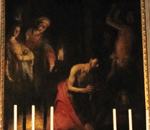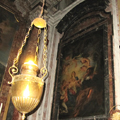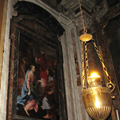SANTA MARIA DELLA SCALA
The construction of Santa Maria della Scala dates back to 1593, when Pope Clement VIII entrusted the design to Francesco da Volterra, who a little later came to death.
The church was completed in 1624.
On the front the statue of the Virgin with the child was sculpted in 1633 by Francis Cusart.
The interior has a nave with three chapels on each side.
The high altar del 1650 si deve a Carlo Rainaldi.
The fresco in the apse represents the Saviour enthroned with the Virgin and Saints.
 |
The Beheading of
St. John in prison |
In the first chapel to the right Gherardo delle Notti (Gerard van Honthorst 1592 to 1656), a follower of Caravaggio like few others, has left one of his best works: the Beheading of St. John in prison.
The most important work of the second chapel on the right, of Antiveduto (=foresight) Grammatica, depicts the Virgin, St. Hyacinth and St. Catherine of Siena.
Antiveduto, refined painter, master of Caravaggio in 1593, owes its name to the fact that his father, himself a painter, had foreseen the circumstances of his birth. Antiveduto was born while his parents were traveling to Rome.
In the third chapel on the right is the altarpiece of Giuseppe Ghezzi (1634 - 1721), the paintings on the sides are, by Giovanni Odazzi (1663 - 1731), The dream of St Joseph and by Lodovico Antonio David (1648 - 1720), The Marriage of the Virgin.
 |
 |
 |
The altarpiece |
The dream of St Joseph |
The Marriage of the Virgin |
In the chapel, which opens on the right transept, altarpiece by Francesco Mancini (1679 – 1758).
Moving to the left of the entrance the altarpiece of the first chapel is by Cristoforo Roncalli (1553 – 1626), known as Pomarancio because he was born in Pomarance.
In the second chapel the altarpiece by Carlo Saraceni (1579 – 1620).
The third chapel shows a wooden crucifix, painted in imitation of bronze and a marble carved in 1726 by Pietro Papaleo.
The chapel overlooking the left transept is dedicated to Santa Maria della Scala, here we can see the tomb of Marquis Santacroce carved by the great Alessandro Algardi (1598 – 1654).
back
|

